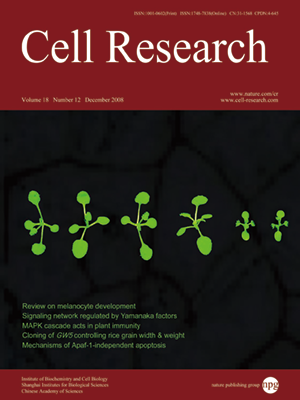
Volume 18, No 12, Dec 2008
ISSN: 1001-0602
EISSN: 1748-7838 2018
impact factor 17.848*
(Clarivate Analytics, 2019)
Volume 18 Issue 12, December 2008: 1177-1189
ORIGINAL ARTICLES
Yamanaka factors critically regulate the developmental signaling network in mouse embryonic stem cells
Xiaosong Liu1, Jinyan Huang2, Taotao Chen1, Ying Wang1, Shunmei Xin1, Jian Li3, Gang Pei1,2 and Jiuhong Kang1
1Laboratory of Molecular Cell Biology, Institute of Biochemistry and Cell Biology, Shanghai Institutes for Biological Sciences, Chinese Academy of Sciences, Shanghai 200031, China
2Department of Bioinformatics, School of Life Sciences and Technology, Tongji University, Shanghai 200092, China
3Agilent Technologies, Shanghai 200001, China
Correspondence: Jiuhong Kang,(jhkang@sibs.ac.cn)
Yamanaka factors (Oct3/4, Sox2, Klf4, c-Myc) are highly expressed in embryonic stem (ES) cells, and their over-expression can induce pluripotency in both mouse and human somatic cells, indicating that these factors regulate the developmental signaling network necessary for ES cell pluripotency. However, systemic analysis of the signaling pathways regulated by Yamanaka factors has not yet been fully described. In this study, we identified the target promoters of endogenous Yamanaka factors on a whole genome scale using ChIP (chromatin immunoprecipitation)-on-chip in E14.1 mouse ES cells, and we found that these four factors co-occupied 58 promoters. Interestingly, when Oct4 and Sox2 were analyzed as core factors, Klf4 functioned to enhance the core factors for development regulation, whereas c-Myc seemed to play a distinct role in regulating metabolism. The pathway analysis revealed that Yamanaka factors collectively regulate a developmental signaling network composed of 16 developmental signaling pathways, nine of which represent earlier unknown pathways in ES cells, including apoptosis and cell-cycle pathways. We further analyzed data from a recent study examining Yamanaka factors in mouse ES cells. Interestingly, this analysis also revealed 16 developmental signaling pathways, of which 14 pathways overlap with the ones revealed by this study, despite that the target genes and the signaling pathways regulated by each individual Yamanaka factor differ significantly between these two datasets. We suggest that Yamanaka factors critically regulate a developmental signaling network composed of approximately a dozen crucial developmental signaling pathways to maintain the pluripotency of ES cells and probably also to induce pluripotent stem cells.
Cell Research (2008) 18:1177-1189. doi: 10.1038/cr.2008.309; published online 25 November 2008
FULL TEXT | PDF
Browse 2016


